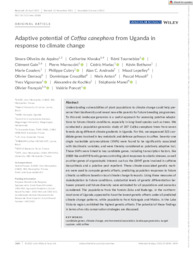Adaptive potential of Coffea canephora from Uganda in response to climate change.
Adaptive potential of Coffea canephora from Uganda in response to climate change.
Autoria: AQUINO, S. O. de; KIWUKA, C.; TOURNEBIZE, R.; GAIN, C.; MARRACCINI, P.; MARIAC, C.; BETHUNE, K.; COUDERC, M.; CUBRY, P.; ANDRADE, A. C.; LEPELLEY, M.; DARRACQ, O.; CROUZILLAT, D.; ANTEN, N.; MUSOLI, P.; VIGOUROUX, Y.; KOCHKO, A. de; MANEL, S.; FRANÇOIS, O.; PONCET, V.
Resumo: Understanding vulnerabilities of plant populations to climate change could help preserve their biodiversity and reveal new elite parents for future breeding programmes. To this end, landscape genomics is a useful approach for assessing putative adaptations to future climatic conditions, especially in long-lived species such as trees. We conducted a population genomics study of 207 Coffea canephora trees from seven forests along different climate gradients in Uganda. For this, we sequenced 323 candidate genes involved in key metabolic and defence pathways in coffee. Seventy-one single nucleotide polymorphisms (SNPs) were found to be significantly associated with bioclimatic variables, and were thereby considered as putatively adaptive loci. These SNPs were linked to key candidate genes, including transcription factors, like DREB-like and MYB family genes controlling plant responses to abiotic stresses, as well as other genes of organoleptic interest, such as the DXMT gene involved in caffeine biosynthesis and a putative pest repellent. These climate-associated genetic markers were used to compute genetic offsets, predicting population responses to future climatic conditions based on local climate change forecasts. Using these measures of maladaptation to future conditions, substantial levels of genetic differentiation between present and future diversity were estimated for all populations and scenarios considered. The populations from the forests Zoka and Budongo, in the northernmost zone of Uganda, appeared to have the lowest genetic offsets under all predicted climate change patterns, while populations from Kalangala and Mabira, in the Lake Victoria region, exhibited the highest genetic offsets. The potential of these findings in terms of ex situ conservation strategies are discussed.
Ano de publicação: 2022
Tipo de publicação: Artigo de periódico
Unidade: Embrapa Café
Palavras-chave: Climate change, Coffea canephora var. ugandae, Genomics, Landscapes, Plant breeding
Observações
1 - Por padrão são exibidas publicações dos últimos 20 anos. Para encontrar publicações mais antigas, configure o filtro ano de publicação, colocando o ano a partir do qual você deseja encontrar publicações. O filtro está na coluna da esquerda na busca acima.
2 - Para ler algumas publicações da Embrapa (apenas as que estão em formato ePub), é necessário ter, no celular ou computador, um desses softwares gratuitos. Sistemas Android: Google Play Livros; IOS: iBooks; Windows e Linux: software Calibre.
Acesse outras publicações
Acesse a Base de Dados da Pesquisa Agropecuária (BDPA) para consultar o acervo completo das bibliotecas da Embrapa.

